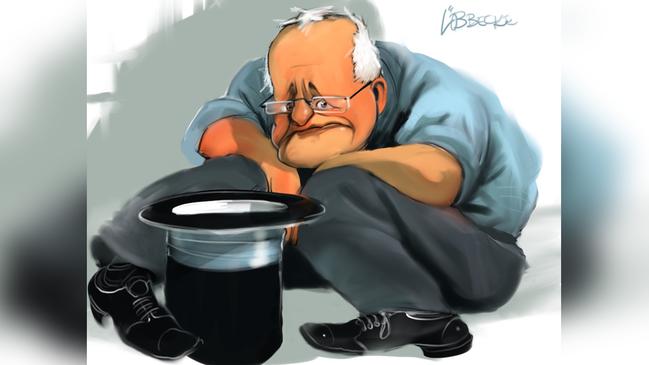Loss of its best fundraisers adds to the Coalition’s woes
And bloodletting is bound to follow the projected defeat in May.

As the song from the 1966 musical Cabaret said: “Money makes the world go ’round”. And so it is for political parties. While it’s far from the only factor that determines success or failure, in the relatively tight contests between major parties in modern elections, the one with more money has a considerable advantage.
Relatively close results in two-party terms actually result in disproportionate wipeouts in terms of seats won and lost.
For example, this week’s Newspoll put the Coalition on a two-party vote of 46 per cent, eight points behind Labor. Translated come election time, such a result would likely see the Coalition lose at least 18 seats, dropping its 74-seat share of the 150-seat House of Representatives to just 56 of 151 seats. (A seat is being abolished at the next election, to be replaced by two new electorates, hence the expanded chamber. )
That certainly looks like a massive loss.
But a 46-54 per cent two-party vote divide only needs to see four out of every 100 voting Australians change their minds before polling day and the election becomes a statistical dead heat. Which does help explain why comebacks can happen, such as John Howard’s defeat of Mark Latham in 2004.
However, the main point is that the variable between so-called landslide results at the federal level (1983, 1996, 2007 and 2013), which usher in a change of government, and near dead-heat elections (1990, 2010 and 2016) is actually not all that significant. On the percentages anyway.
In all of the above cases, as well as most other elections, money and campaign techniques play a huge role in which party wins and which loses. This naturally affects the national vote, but more importantly can swing results in key seats.
At a macro level, these factors can flip the results of close elections, as in 1998, when a well-financed and better campaign team supporting John Howard won the election with just 48.9 per cent of the two-party vote. By sandbagging key seats.
More money and campaigning strength can also narrow an otherwise big victory on the two-party vote, as in 2007, when Kevin Rudd’s Labor opposition defeated the Howard government with nearly 53 per cent of the two-party vote but only secured an eight-seat majority.
This year’s election is a dangerous one for the Coalition because not only are the polls showing it heading towards a likely defeat but the momentum is with Labor and the instability is all on the government’s side. Plus, the money and the campaign strengths are also significantly benefiting Labor.
Such a confluence of circumstances risks an electoral catastrophe for the Coalition.
At the 2016 election the Coalition had four important factors going its way when it came to campaign financing that no longer are.
The prime minister was the party’s biggest donor. Malcolm Turnbull dropped in excess of a million dollars into the campaign, and we know he went on to win the election by a few hundred votes in one seat, with the barest of majorities. Money matters. At this election I doubt he’ll donate a cent to Scott Morrison’s campaign.
Second, the Liberal deputy at the previous election, Julie Bishop, was the party’s best fundraiser within the corporate community. But having announced her retirement and being humiliated in the leadership ballot as well as the contest to find a replacement for her blue-ribbon seat, Bishop also won’t lift a finger this time around.
Third, Craig Laundy is expected to retire at the next election, and probably won’t raise funds for the Liberals (at least not much). The wealthiest member of the parliament now that Turnbull is gone, he is well tapped into the clubs and pubs scene and knows a thing or two about convincing people to part with their money for a political cause. But Laundy, who accompanied Turnbull on the long walk to the partyroom when the final spill was to be conducted, isn’t feeling particularly generous towards the party right now.
Finally, the loss of Barnaby Joyce as Nationals leader has crippled the Nationals’ capacity to raise funds — both within the mining sector and via smaller donations across regional communities. Joyce’s fall from grace removed the best fundraising asset the Nationals had from the leadership, a point often forgotten in discussions that focus on his one-time “retail” political skills.
Making matters worse for a cash-strapped Coalition is the series of challenges it faces in safe seats from third-party candidates — independents and Greens fed up with the rightward drift of the government. Such candidates mean the Coalition will need to spend more on previously safe seats than it otherwise would, draining cash and human capital from marginal-seat contests.
Even the rise of third party endorsements is working against the Coalition’s interests. The GetUp campaign is far better resourced than its start-up conservative equivalent, Advance Australia. And it has better campaigning skills to boot, having targeted seats before and built up experience and data on electors, enabling it to get more value for money out of its already better-resourced cash reserves.
In contrast to the financial woes of the Coalition, Bill Shorten’s opposition is heavily backed by a union movement that can see the potential policy windfall it will receive if Labor wins — for its members and for its broader ideological aims. Plus, the scent of victory is seeing the ever fickle business community starting to throw money Labor’s way, reflecting that old adage that success has a thousand fathers, failure is an orphan.
Because Labor is expected to win, most rent-seekers and businesses whose success is tied to government decision-making want to be Shorten’s friend. Or at least show that they weren’t too hostile to his rise to power.
The risk for the Coalition at the next election is that the defeat that is well and truly in the offing becomes a generational blowout when the resource disadvantage it is suffering from is added to the equation. And with such failure, the post-defeat bloodletting will only intensify. Especially because there hasn’t really been a proper period of introspection by the conservative side of politics since the 1980s.
Howard in government ensured the battle of ideas within the party was largely restricted to the practical. After the 2007 defeat, because the Coalition was quickly back in the political contest at the following election, divisions were papered over in the name of chasing victory. While no one would claim the Coalition hasn’t been divided during both terms of government, the cracks within become much more significant when they form in opposition.
Because that’s when serious arguments ensue about philosophical directions parties should take, whether cleanouts and quotas should be adopted. Or whether the Nationals would be better off breaking away from the Coalition when in opposition.
These debates can be healthy in the long run, as is borne out by the role of the 80s debates in creating philosophical direction for Howard’s government alongside a desire for unity. But in the short term they are debilitating.
Peter van Onselen is a professor of politics at the University of Western Australia and Griffith University.



